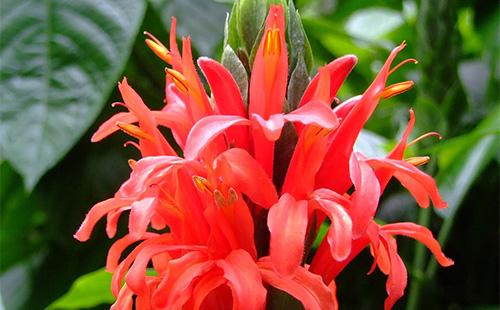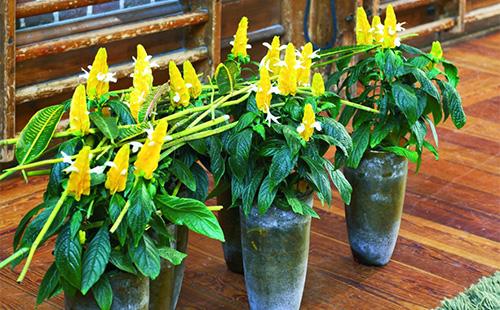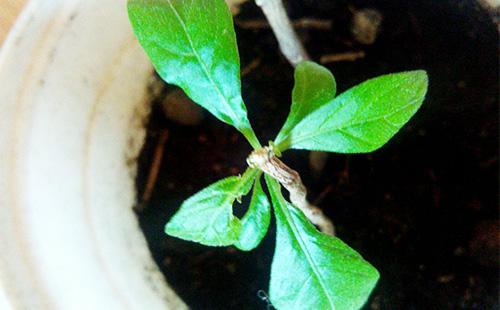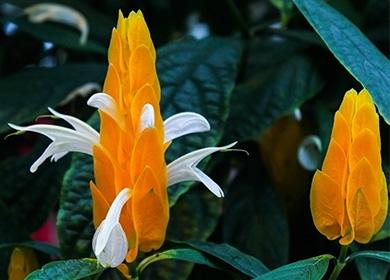The content of the article
In general, there are 12 species of this plant, but only two of them have taken root in our country: yellow (Pachystachys lutea) and red (Pachystachys coccinea). But red is a rarity. The bulk of home pachistachis (pachyrachis) is yellow.
Special Signs and Superstitions
Why does a plant fall leaves? The appearance of pachistachis inflorescences is very unusual. In the spring, on a long stem, at the very top, a green "spike" grows (up to 13 cm long), densely strewn with small buds. People call it “candle”, “bump” and even “ear”. In May-June, yellow (or red) flowers open. In the case of yellow pachistachis, the candle really resembles a corncob. Surprisingly, this is not the flowering itself, but only bracts. And the pachistachis flower itself is white (about 5 cm in length), has only two lips and grows perpendicular to the bract. After a couple of days, the flower falls, and the bracts continue to “burn” until the fall.
The leaves of the pachistachis are dense, glossy, bright green, similar in shape to a very elongated oval. The veins are thick, giving the leaves a relief and texture. Length - about 10 cm. And the height of the flower itself is 50-60 cm, sometimes there are specimens up to 80 cm high. Red pachistachis is larger - in size it can be twice the size of its yellow counterpart.
Pachistachis Care: The Basics
A lot of “theory” has been written about how to care for pachistachis in a pot. And according to the description, everything seems to be simple, but in practice, many amateur gardeners fight and cannot find a “common language” with the flower. And this happens because the plant "does not forgive" forgetfulness, and one violation of the rules of care can negate all previous efforts.
Where to put
Pachistachis is a tropical plant and, accordingly, loves the sun and humidity. But at the same time, direct rays “burn” the leaves - they turn yellow and fall off. It turns out that you need to find a place in the house that meets three basic requirements.
- Lighting. There should be a lot of light. But not direct - scattered. It is better if it is a shaded place on the balcony, and if the window sill - then by the window facing east or west. Especially dangerous is the summer midday sun. If, nevertheless, direct rays of the sun fall on the flower, cover the pachistachis with a curtain or just a piece of cloth during these hours. In winter, on the contrary, there is little sunlight, so you need to provide the plant with additional artificial lighting or rearrange it on a more suitable window.
- Temperature. The maximum temperature of pachistachis is 22-25 ° C. Minimum - 12-14 ° C. In summer, look for a cooler place for him, in winter - warmer. The flower can survive at a temperature of −10 ° C, but the leaves will inevitably be lost and the plant will recover heavily and for a long time. He is also “sick” from the heat: he loses foliage, ceases to bloom.
- Drafts. Draft pachistachis does not tolerate. Therefore, when choosing a place, check whether it blows from a window.And also pay attention to the direction of the air flow from the air conditioner and heating devices - there should not be either one or the other.
How to water
Pachistachis is born in a tropical climate and, of course, it is still a “water chowder”. During the hot season, you need to water it often - every time, as soon as you notice that the top layer of soil has dried up. But do not “get carried away” - it is also impossible to overfill, otherwise the roots will begin to rot. Do not allow liquid to accumulate in the pan; if you notice, pour it safely. It is better to water more often, but less. In the summer, you may have to do this daily.
In winter, an average of one watering per week is sufficient. Drying of the topsoil is allowed, but if the earth is also dry at a depth of 1-2 cm, it is necessary to water the plant. Water should be left at room temperature
When to feed
Pachistachis begins to awaken in early March. It is at this time that you can begin to feed the flower. Complex fertilizers for decorative flowering plants are best suited for him. Feeding is recommended once a month throughout the flowering period, that is, until the fall.
How to achieve splendor
In the early years of its development, pachistachis has only one stem and, accordingly, one candle. Moreover, as the plant grows, the lower part of the trunk is “bare”, which greatly spoils the appearance of the flower. Here are two rules on how to care for pachistachis to get a lush bush with lots of candles.
- Topping. That's right - do not trim the pachistachis after flowering, but pinch it. That is, when the plant completely fades, you need to pinch all the available tops. This will not allow the plant to stretch upwards, but, on the contrary, will force it to develop lateral shoots. Thus, you will increase the number of stems and, accordingly, there will be more blooming candles. But a one-time procedure is indispensable here - in the first year of life you need to spend three or four such pinching, and in subsequent years, two are enough (after flowering and after pruning). And so you can control the shape of the bush at your discretion.
- Pruning. Trimming pachistachis is necessary at the very beginning of spring, when the plant "wakes up." You need to leave three pairs of leaves, you get stems 10-15 cm long from the ground. On the side shoots - pinch off the upper pairs of leaves.
Transfer
Pachistachis is a perennial. Moreover, the root system in young plants is developing quite intensively. Therefore, they will have to be transplanted every year, or rather, every spring. Older plants less often - once every three years. And here are some points you need to pay attention to when transplanting.
- Pot. Each subsequent year you need to pick up a pot of larger diameter. It is better that it be low and wide, rather than tall and narrow.
- The soil. The ground for pachistachis must pass air well, that is, it must be loose.You can mix peat, leaf, turf soil, sand and humus in approximately the same amount with your own hands. And you can buy ready-made slightly acidic soil for flowering plants.
- Drainage. It must be. Indeed, pachistachis loves moisture and frequent watering can lead to rotting of the roots. Therefore, before pouring soil into the pot, lay a layer of expanded clay on the bottom (2 cm is enough). If there is no expanded clay, simple medium-sized pebbles will do.

Breeding
Pachistachis can be propagated at any time, except during the dormant period, that is, from early spring to autumn. You will need “live” cuttings. And here's how to get them:
- take the tops left after spring trimming - only those on which three or four nodes are useful;
- after flowering, cut off the top of the stem - together with the bract (after planting, it will dry up and fall off) 10-15 cm long.
When the cuttings are prepared, follow the instructions in five steps.
- Immerse the cuttings in water (or you can immediately into a mixture of peat and sand).
- Make a greenhouse: cover the container with a bag or glass jar.
- Open the greenhouse for half an hour daily, ventilate and spray.
- After three weeks, the plant will take root and it will be possible to plant the cuttings in pots.
- When at least two pairs of leaves appear, pachistachis can be placed on the windowsill.
To create a greenhouse it is convenient to use a cut plastic bottle: pour soil into the lower part (pierce the holes in the bottom), and put the upper one on the lower one, like a cap.
According to the reviews of some gardeners, you can simply “stick” the stem into the ground next to the parent plant, cover it with a “cap” and leave it to take root. And after three to four weeks - boldly plant young pachistachis in new pots.
Diseases and treatments
Pachistachis is sensitive to changing conditions. You may not even notice the changes, and the plant will already respond with “baldness” or lethargy. The table below describes the options for atypical flower conditions, the causes of their occurrence and methods of treating "diseases".
Table - Diseases of the pachistachis and methods for their treatment
| Phenomenon | Cause | Remedy |
|---|---|---|
| Leaves turn yellow and fall (during flowering) | - not enough moisture | - Review the irrigation mode in the direction of increased frequency; - spray the plant more often |
| Leaves dry around the edges. | - dry air | - Spray a flower several times a day; - put a container of water next to it |
| Leaves fall off (during dormancy) | - The flower is cold | - Warm up the room to about 20 ° C; - keep the temperature at the same level |
| Leaves curl | - Little light | - Move the pot to a more lighted place |
| Root decay | - Stagnant water in the pan; - sudden changes in temperature; - the flower is cold | - If there is water in the pan, pour it out and let the soil dry; - normalize the temperature in the room and maintain it at a stable level; - if the root system is severely affected, then transplant the plant |
| Does not bloom | - Pachistachis is “starving”; - insufficient watering | - Water the plant more often; - increase the amount of feeding up to two times a month |
| Slow growth | - lack of nutrients | - Take the bait up to three times a month, but reduce the dosage by half |
| The stems are stretched, and the leaves are smaller | - Little light | - Move the pot to a more lighted place or place a lighting fixture nearby |
Pests
If you are sure that all conditions are met and there are no drafts, but the leaves of the pachistachis nevertheless curl and fall, take a closer look at the flower - perhaps it was “attacked” by pests. First of all, the affected plant must be isolated from the "neighbors" in order to avoid infection.
The easiest and most reliable way to deal with "uninvited guests" - insecticides. Buy the finished product in the store (a consultant will help you with the choice of the drug) and follow the manufacturer's recommendations for dosage and use. Remember: these substances do not kill the eggs of insects - the treatment will have to be repeated. Or use one of the folk methods described below.

Aphid
Aphids - small bugs up to 1 mm long in light green color, can also have pink, yellow, black color. Characteristic signs of aphid damage:
- leaves twist and fall;
- bracts fade;
- a pad appears, from which the leaves become sticky.
Favorite habitats: the back of the leaves and the base of young shoots. Here their colonies are visible with the naked eye. Remove affected stems and leaves without regret. And then - select the appropriate method of struggle from the table, and act immediately.
Table - Methods of killing aphids
| Method | Instruction manual |
|---|---|
| Manual cleaning (helps when there are few insects) | - Remove all affected parts of the plant; - rinse the flower under a stream of warm running water |
| Soap solution | - Dilute 1 part of laundry soap in 6 parts of water; - moisten a sponge and wipe the plant completely; - after the solution has dried, rinse the flower with clean water |
| Alcohol | - Wipe the entire surface of the flower with a cotton swab dipped in alcohol |
| Garlic | - Grind 1 head of garlic and pour a liter of water; - insist at least a day, and preferably 3-5 days; - add a teaspoon of grated soap; - spray the plant from all sides |
| Mustard | - 1 tablespoon of mustard powder pour a liter of water; - insist 2 days; - spray the plant from all sides |
Spider mite
A spider mite is such a meager creature that not everyone can see it. The body length of the insect is a maximum of half a millimeter. But its presence can be suspected by the following signs:
- small white cobwebs appear on the plant - Especially often they are visible in the places of attachment of the processes;
- brown spots are barely noticeable on the back of the leaves - if you touch them, they quickly scatter;
- the plant weakens - and the foliage falls.
At the first suspicion of a parasite, remove the pachistachis away from other flowers - the tick easily moves to its “neighbors”. Then cut off all the affected parts of the flower. Next - choose the appropriate method of struggle from the table.
Table - Methods of combating spider mites
| Method | Instruction manual |
|---|---|
| Laundry soap | - Wet a rag or sponge and rub on a piece of soap; - lather; - process the plant, pot, tray and everything that is nearby, including the support, walls, windows, windowsill; - let the foam dry; - rinse the plant with a clean rag; - put on a plastic bag and tie it at the bottom of the pot; - remove the package at least after one day, and preferably after three |
| Garlic | - Grind 1 head of garlic and pour a liter of water; - insist at least a day, and preferably 3-5 days; - add a teaspoon of grated soap; - spray from all sides the plant itself and everything that is near it |
| Alcohol | - Spray alcohol on the pachistachis from all sides from the spray gun; - do not forget to process the pot and adjacent surfaces |
| Amblyseyus (or phytoseyus) | - Buy predatory ticks in the store; - release in a pot with pachistachis |

Whitefly
The name speaks for itself - it is an insect with white wings. The average length is 2 mm. Whitefly multiplies very quickly, so adult parasites, larvae, and eggs can be present on one leaf at once.Moreover, it is precisely the larvae that suck the juices from plant cells that harm the flower. At the slightest air shock, adult whiteflies fly away, the eggs are almost invisible to the naked eye, and the larvae can easily be mistaken for scale insects. Therefore, it is important not to make a mistake with the “diagnosis”. Here are the characteristic signs of the presence of whiteflies:
- near the plant you can see small white "midges";
- “corroded” spots appear on the leaves;
- there is a sticky pad;
- pachistachis wilts, discards leaves, stops flowering.
Affected areas need to be cut off. In addition, change the topsoil (about 2 cm) and try to use a vacuum cleaner to “catch” as many scattered individuals as possible. And only then proceed to the extermination of insects. The best methods are described in the table below.
Table - Whitefly Control Methods
| Method | Instruction manual |
|---|---|
| Soap-alcohol solution | - Make a liter of soapy solution; - add 3 tablespoons of alcohol to it; - treat the plant from all sides; - wipe the composition of the pot and all adjacent planes; - let the solution dry; - rinse with clean water |
| Garlic | - Grind 1 head of garlic and pour a liter of water; - insist at least a day, and preferably 3-5 days; - add a teaspoon of grated soap; - spray from all sides the plant itself and everything that is near it |
| Systemic insecticides | - Dilute the drug according to the instructions; - treat the plant and adjacent surfaces; - Cover the plant with a pot of polyethylene for two hours; - repeat once a week until the complete destruction of the pests (at least one and a half to two months) |
Mealybugs
If you find something similar to small pieces of glued cotton wool on the pachistachis, most likely your mealybug has “visited” your flower. The insect itself looks like a wood lice, but only 3 to 7 mm in size. And “vata” is a secret secreted by a worm. Under it, the insect “stores” egg clutches and hides itself. Signs of a mealybug defeat:
- the flower "withers" - discards leaves, stops growing;
- “Vata” prevents light from entering - the leaves turn yellow and curl;
- the parasite gets to the roots - they rot, pachistachis “starving”;
- rot develops on the plant - and mold.
Insects move quickly and pretty soon hit neighboring plants, so the fight must begin immediately. In this case, the same methods as described for controlling whiteflies are suitable. Processing of pachistachis should be carried out twice a week until all reptiles are destroyed.

Shield
This insect has a "shell". The scabbard tightly sticks to the flower, and a strong growth on top protects it from external influences. The parasite feeds on plant juices, which leads to its slow death. Here are the "symptoms" characteristic of affection with the scale:
- brown "plaques" of about 2 mm in size - this is a scale shield;
- sticky pad;
- from the place of attachment of the parasite, a dry “dead” spot grows;
- pachistachis wilts and discards leaves.
Complete plant isolation is the first thing you should do. Then mechanically remove all visible insects from the pachistachis and rinse it under a stream of warm water. Choose a method from the table below and proceed.
Table - Methods of combating scale insects
| Method | Instruction manual |
|---|---|
| Garlic | - Grind 1 head of garlic and pour a liter of water; - insist at least a day, and preferably 3-5 days; - add a teaspoon of grated soap; - spray from all sides the plant itself and everything that is near it |
| Kerosene | - Dilute the soap solution (2 tablespoons of crushed soap per liter of water); - drip there 5 drops of kerosene; - cover the soil with polyethylene; - spray the plant completely |
| Alcohol | - Dilute alcohol twice with water (you can use vodka in its pure form); - treat pachistachis on all sides (wipe or sprinkle); - repeat every other day |
And the hygiene of the plant was and remains the best way of prevention: more often spray the pachistachis with clean water, wipe the dust from the leaves, observe the temperature regime and do not “fill” the flower too much when watering. And then growing pachistachis at home will bring you only positive emotions.
Reviews: "Sunny Flower"
Pachistachis - was popular back in the 19th century. was forgotten for many years and again became a wonderful gift for flower lovers. Unfortunately, it is rather capricious, but painstaking work will bring joy when the flowering of the “candle” will decorate your home.
A guest, http://chvetochki.ru/pakhistakhis/
The main thing to remember is that Pachistachis is a sunny flower. Therefore, it must be kept on the windowsill of the east or south side. On the southern windowsill in the hottest months (July, beginning of August), cover with a little foliage a nearby plant or put closer to the side wall of the window, where the rays will be more gliding.
And second, he loves water, immediately reacts negatively to the crossed earthen lump. The substrate should always be not wet, but moist. These are the most important things for him. Everything else is as always: in early spring, fertilizing for decorative and deciduous plants, then alternating with fertilizers for flowering plants, with a smooth transition to fertilizing, especially for flowering plants
Nika https://forum.bestflowers.ru/t/paxistaxis-uxod-v-domashnix-uslovijax.1902/page-3
The invaluable experience of a familiar florist has shown that by strangling the "toad" and forgetting to bloom for a year, we constantly cut the pachistachis - we form a bush, and then we only maintain this state - believe me, the pleasure is worth more than 30 candelabra !!! And they bloom for a long time, especially since each flowering branch is cut and gives new offspring.
A-Dav, http://forum-flower.ru/showthread.php?t=18

